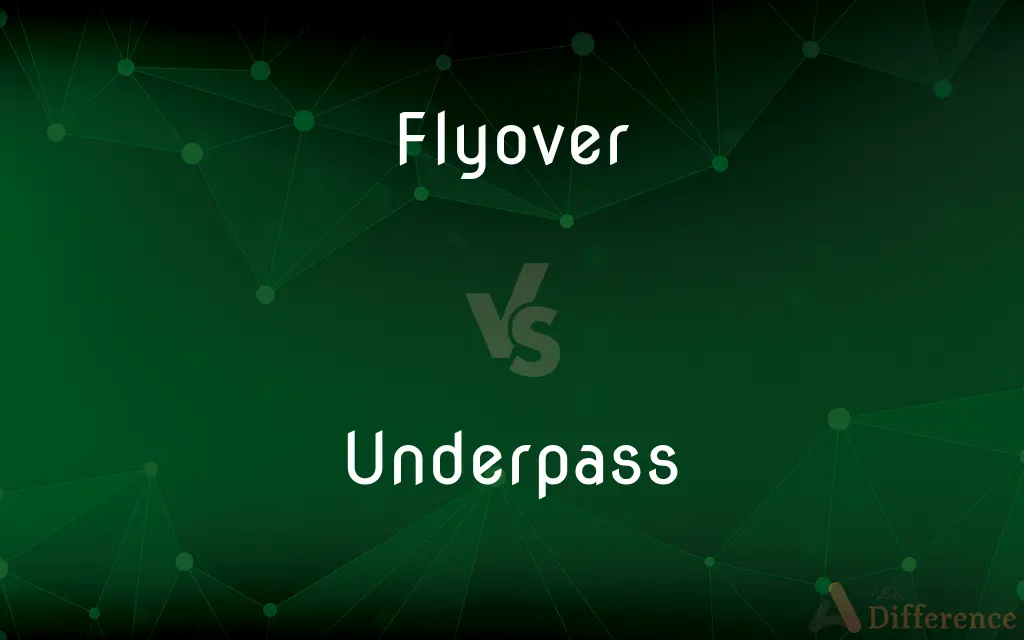Flyover vs. Underpass — What's the Difference?
By Tayyaba Rehman & Urooj Arif — Updated on March 14, 2024
A flyover is an elevated road allowing traffic to bypass intersections, while an underpass is a tunnel below roads or railways for similar purposes. Both address traffic flow but from different vertical perspectives.

Difference Between Flyover and Underpass
Table of Contents
ADVERTISEMENT
Key Differences
Flyovers are constructed above ground level to provide an uninterrupted path for vehicular traffic, reducing congestion at busy intersections. Whereas, underpasses are built beneath roads, railways, or other barriers, allowing vehicles, pedestrians, or animals to cross without interfering with the traffic above.
Flyovers require significant vertical space and are often used in areas where land availability is not a constraint. On the other hand, underpasses, being subterranean, are preferred in densely populated or urban areas where space above ground is limited.
The construction of a flyover is usually more visible and can become a landmark in its own right, contributing to the city's skyline. Whereas underpasses are less obtrusive to the landscape, preserving the aesthetics of the environment above ground.
Flyovers often involve more complex engineering and construction work due to their height and the need for sturdy supports, making them more expensive and time-consuming to build. On the other hand, underpasses, while still challenging, might require less structural engineering above ground but face issues like water drainage and lighting.
In terms of user experience, flyovers offer a panoramic view of the surrounding area and are generally well-ventilated. Underpasses, however, can be perceived as less pleasant due to their enclosed nature and the need for artificial lighting and ventilation systems.
ADVERTISEMENT
Comparison Chart
Location
Above ground
Below ground
Construction Impact
Visible, can alter skyline
Less obtrusive, preserves landscape aesthetics
Engineering Complexity
High, requires sturdy supports
Moderate, challenges with drainage and lighting
Preferred Use
Areas with available vertical space
Densely populated or urban areas
User Experience
Panoramic views, well-ventilated
Enclosed, requires artificial lighting and ventilation
Compare with Definitions
Flyover
A landmark feature in modern urban planning.
The iconic flyover has become a recognized symbol of the city's growth.
Underpass
Can also accommodate cyclists and pedestrians.
The underpass includes a dedicated bike lane for safer cycling routes.
Flyover
An elevated roadway providing an uninterrupted route over a junction.
The newly built flyover has drastically reduced commute times in the city.
Underpass
A tunnel allowing passage under a road or railway.
The underpass provides a safe crossing for pedestrians near the school.
Flyover
A bridge-like infrastructure allowing traffic to bypass congestion.
The urban development plan includes a flyover to ease rush hour traffic.
Underpass
Often equipped with lighting and drainage systems.
The well-lit underpass ensures safe passage for vehicles at night.
Flyover
A structure designed to carry one roadway over another.
The flyover connects two major highways, facilitating smoother traffic flow.
Underpass
Designed to facilitate the movement of traffic without interruption.
The new underpass has eased the flow of traffic into the city center.
Flyover
Used to avoid traffic signals and intersections.
Driving over the flyover, we skipped three traffic lights.
Underpass
Helps in maintaining the aesthetic integrity of landscapes.
The construction of the underpass preserved the historic park above.
Flyover
A flight over a specific location, usually at low altitude, as by a formation of military aircraft.
Underpass
A road or pedestrian tunnel passing under a road or railway.
Flyover
Chiefly British An overpass, as on a highway.
Underpass
A passage underneath something, especially a section of road that passes under another road or a railroad.
Flyover
(Informal) Of or relating to the interior region of the United States and Canada, ostensibly regarded as provincial or dull by residents of urban areas along the coasts. Used attributively
A flyover state.
Flyover cities.
Underpass
An intersection formed in this way.
Flyover
(US) A low-level flight, especially of military aircraft, of a ceremonial nature; a flypast British.
Underpass
A passage that crosses a road, railroad or similar obstacle in a tunnel underneath it.
Flyover
A road or railway that passes over another, allowing routes to cross without interruption.
Underpass
An underground tunnel or passage enabling pedestrians to cross a road or railway
Flyover
(US) A high-level overpass built above main overpass lanes.
Flyover
The upper level of a crossing of two highways at different levels; called in the United States an overpass; as, an overpass is called a flyover or a flypast in England.
Flyover
A low-altitude flight (usually of military aircraft) over spectators on the ground.
Flyover
Bridge formed by the upper level of a crossing of two highways at different levels;
An overpass is called a flyover or a flypast in England
Flyover
A low-altitude flight (usually of military aircraft) over spectators on the ground
Common Curiosities
How do flyovers affect traffic flow?
Flyovers improve traffic flow by allowing vehicles to bypass busy intersections or areas of high congestion without stopping.
What is a flyover?
A flyover is an elevated roadway designed to carry traffic over other roads or obstacles, reducing congestion.
Can flyovers be used by pedestrians?
Some flyovers include pedestrian pathways, but primarily, they are designed for vehicular traffic.
Are flyovers more expensive than underpasses?
Generally, flyovers are more expensive due to their complex structural requirements and the materials needed for elevated construction.
How do underpasses handle water drainage?
Underpasses are designed with drainage systems to prevent water accumulation, ensuring safe and dry passage.
What is an underpass?
An underpass is a tunnel constructed under roadways, railways, or other barriers, allowing for the uninterrupted flow of traffic or pedestrian movement.
What are the advantages of underpasses?
Underpasses reduce surface-level congestion and enhance safety by separating different streams of traffic.
Are underpasses safe for pedestrians?
Yes, when properly designed with adequate lighting, signage, and maintenance, underpasses are safe for pedestrian use.
What materials are used to build flyovers?
Flyovers are typically constructed using reinforced concrete, steel, or a combination of both for durability and strength.
Can both flyovers and underpasses be found in urban areas?
Yes, both are used in urban planning to improve traffic flow and pedestrian safety, depending on space and environmental considerations.
Why are flyovers considered landmarks?
Due to their size, design, and impact on the skyline, flyovers can become recognizable features of a city's landscape.
Do flyovers require maintenance?
Yes, like all infrastructure, flyovers require regular maintenance to ensure their structural integrity and safety.
What is the primary purpose of underpasses and flyovers?
The primary purpose is to improve traffic flow by allowing vehicles and pedestrians to bypass intersections or barriers without interference.
How long does it take to construct an underpass?
The construction time for an underpass varies based on its size, design complexity, and the conditions of the site.
How do underpasses affect the environment?
Underpasses, being less visually intrusive, can preserve the natural or built environment above them.
Share Your Discovery

Previous Comparison
Duke vs. Count
Next Comparison
Apophantic vs. ApophaticAuthor Spotlight
Written by
Tayyaba RehmanTayyaba Rehman is a distinguished writer, currently serving as a primary contributor to askdifference.com. As a researcher in semantics and etymology, Tayyaba's passion for the complexity of languages and their distinctions has found a perfect home on the platform. Tayyaba delves into the intricacies of language, distinguishing between commonly confused words and phrases, thereby providing clarity for readers worldwide.
Co-written by
Urooj ArifUrooj is a skilled content writer at Ask Difference, known for her exceptional ability to simplify complex topics into engaging and informative content. With a passion for research and a flair for clear, concise writing, she consistently delivers articles that resonate with our diverse audience.














































